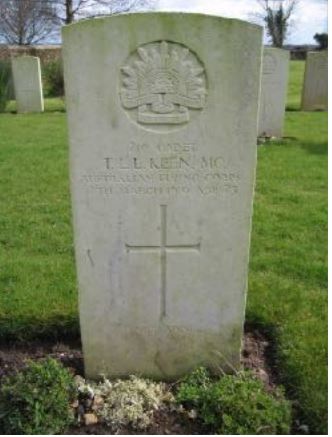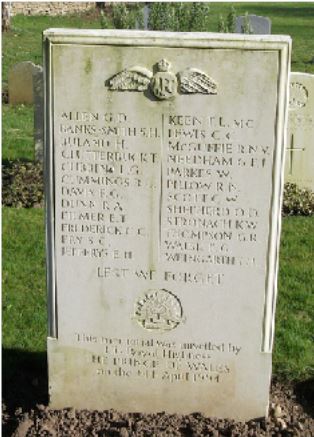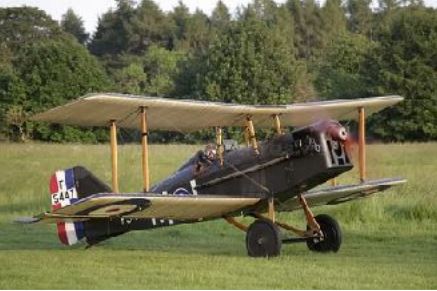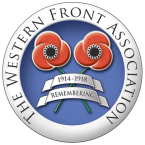6th Training Squadron, Australian Flying Corps

Thomas Llewellyn Keen is the only Australian Flying Corps (AFC) man buried at Leighterton who was the recipient of the Military Cross. He was also buried on the day that AFC activity at both Minchinhampton and Leighterton aerodromes came to an end. In many ways his eventful service career reflected that of the ANZACs in general.
He was English born, in Canterbury, Kent in mid-1890, the son of Thomas Benion and Mary Keen (who was Irish). The couple had seven children: Thomas died in 1912, when serving as a Staff Sergeant in the Army Pay Corps and living in Pimlico. Mary was living at 57 Heathfield Avenue, Dover.
Probably towards the end of the early 1900s Thomas (junior) emigrated to Australia and became a station overseer at Sydney, New South Wales (NSW). He enlisted as a Trooper, number 210, at Liverpool, NSW on 30 October 1914, aged 24 years and four months and was posted to the 7th Light Horse (LH) ‘A’ Squadron, who had recruited in NSW.
He left Sydney, aboard the HMAT Ayrshire (A33) on 20 December 1914, arriving in Egypt on 1 February 1915.
After a stay in Egypt, the 7th LH (part of 2nd Light Horse Brigade) was sent to Gallipoli, landing on 15 May 1915. Here, in August, Trooper Keen was rapidly promoted to Squadron Sergeant Major. Like so many troops at Gallipoli he suffered from the insanitary conditions, together with the heat and flies. On 2 October 1915 he was evacuated to 6th General Hospital, Alexandria, suffering from dysentery. On 20 October he was reported to be ‘dangerously ill’ but by 2 November was out of danger, although he was not fit to return to his unit until 4 February 1916. Promotion to Warrant Officer, Regimental Sergeant Major, followed on 24 February.
Having, it appears, visited some of the less salubrious areas of Alexandria he had to undergo over 30 days treatment for venereal disease and was away from his unit until 4 May 1916. On 30 October 1916 he was tried by a Field General Court Martial, accused of drunkenness in a public restaurant and conduct prejudicial to good order. He denied the charge and was acquitted.
On 24 May 1917 he was sent on detached duty to the Light Horse Training Regiment in Palestine. He had to leave them on 2 January 1918, on being admitted to hospital with tonsillitis and after about a month at a recuperation camp, he returned to the 7th LH on 22 February.
On 16 April he was awarded the Military Cross, the award appearing in the Third Supplement of the London Gazette No 30901 of 16 September 1918. The citation read: ‘for conspicuous gallantry and devotion to duty in maintaining communications between squadrons of Light Horse. To do this he had to expose himself to exceptionally heavy rifle and machine gun fire and it was owing to his recourse in taking and sending messages that the regiment was kept together’.
The newly decorated RSM Keen left Egypt on 24 May 1918, aboard the HMAT Indarra, bound for the UK and a Cadetship in the AFC. After landing at Southampton on 5 June he travelled to the AFC Depot at Halton Camp, Wendover, Bucks., prior to attendance at No 2 School of Military Aeronautics, Oxford (5 July – 16 August) and the RAF Armament School, Uxbridge (17 August to 14 September). It was then back to Wendover, prior to a posting to 6th Training Squadron at Minchinhampton Aerodrome (later called Aston Down) on 23 September. In January 1919 he spent a short time in Tetbury Cottage Hospital with knee ligament problems.
It was misty over the Tetbury area on 12 March 1919. Cadet Thomas Keen had taken off from Rendcomb aerodrome at about 9.55am, flying a SE5A fighter (serial number D3499: picture of type shown below) to Minchinhampton. Flying alongside him, in a separate aeroplane was his instructor Captain Holden: he observed Keen’s SE5A fly into a cloud or bank of mist over Miserden Park, near Sheepscombe, possibly reducing height to ascertain position. The Gloucestershire Echo reported that a land girl, named Excell, saw the aircraft descend into a wood and crash into a felled tree. She summoned assistance but Thomas Keen was found dead, having broken his neck. He was aged 28. An inquest was held, which concluded death was a result of ‘accident in flying’.
Cadet Thomas Keen was buried in Leighterton Church Cemetery, on 15 March 1919 and a CWGC headstone now marks his grave. The award of the Military Cross is signified on the headstone but not, surprisingly, in the CWGC register. He is also commemorated on the St Barnabas Church, Dover, War Memorial Tablet, as one of the communicants of the church who gave their lives.


Researched by Graham Adams 2 February 2018
